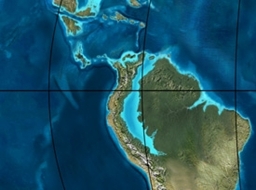Top Qs
Timeline
Chat
Perspective
Regadera Formation
Geological formation of the Colombian Andes From Wikipedia, the free encyclopedia
Remove ads
The Regadera Formation (Spanish: Formación Regadera, E2r, Tpr) is a geological formation of the Bogotá savanna, Altiplano Cundiboyacense, Eastern Ranges of the Colombian Andes. The predominantly sandstone and conglomeratic formation, with pink shale beds intercalated, dates to the Paleogene period; Middle to Late Eocene epoch, and has a maximum thickness of 765 metres (2,510 ft).
Remove ads
Etymology
The formation was first described by Hubach in 1931 as part of the Usme Formation and redefined and named in 1963 by Julivert after the La Regadera Reservoir.[1]
Description
Lithologies
The Regadera Formation consists mainly of quartz arenitic sandstone and conglomerates with some shale beds.[1][2]
Stratigraphy and depositional environment
The Regadera Formation overlies the Bogotá Formation and is overlain by the Usme and Tilatá Formations. The age has been estimated, based on palynological data of Echitriporites trianguliformis var. orbicularis, Nothofagidites sp. and Multiporopollenites pauciporatus, to be Middle to Late Eocene.[3] The depositional environment has been interpreted as a braided river setting.[4]
Remove ads
Outcrops
The Regadera Formation is apart from its type locality in the synclinal of Usme, the valley of the Tunjuelo River, found in the synclinal of Sisga.[1] In the Tunjuelo River valley, the Regadera Formations is present in the escarpments on the river banks.[5]
Regional correlations
- Legend
- group
- important formation
- fossiliferous formation
- minor formation
- (age in Ma)
- proximal Llanos (Medina)[note 1]
- distal Llanos (Saltarin 1A well)[note 2]
Remove ads
See also
Notes and references
External links
Wikiwand - on
Seamless Wikipedia browsing. On steroids.
Remove ads



























